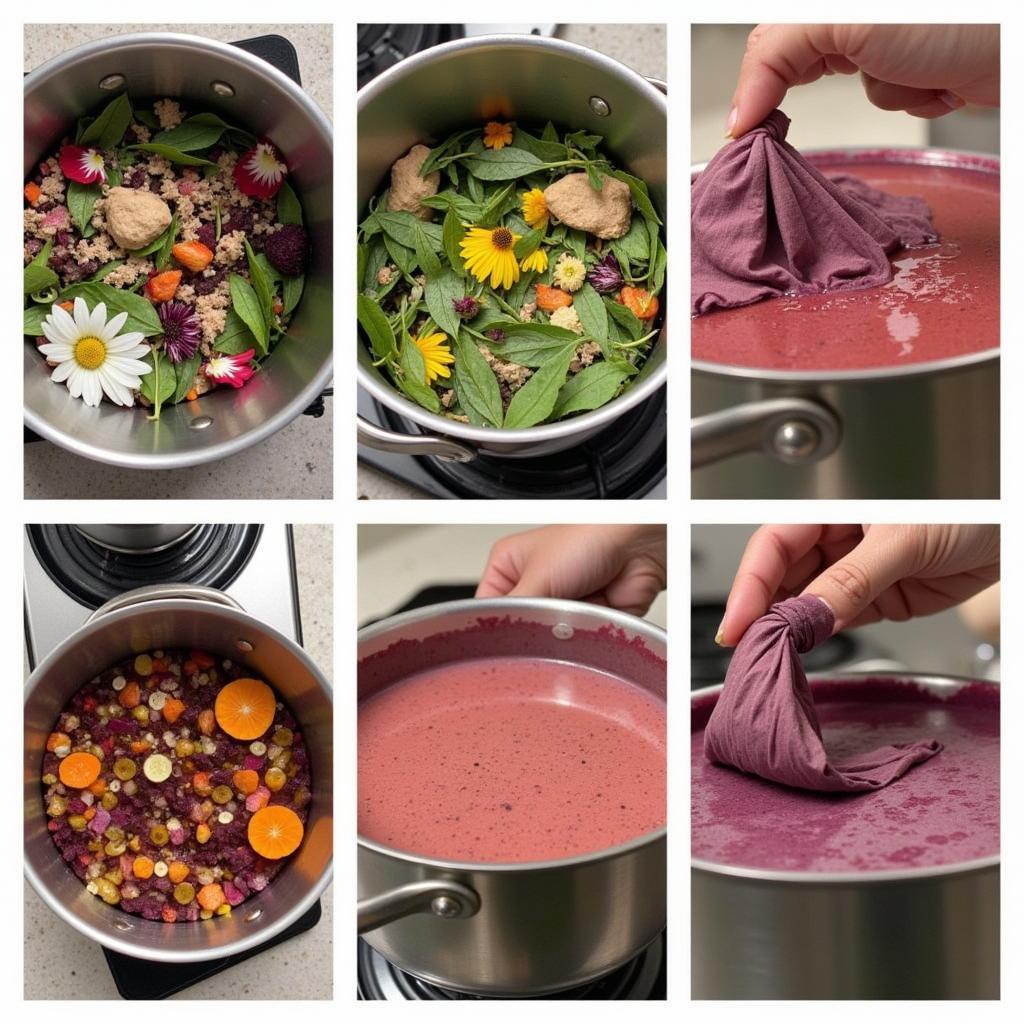Botanical Dyed Clothing is gaining popularity as a sustainable and eco-friendly alternative to conventional dyeing methods. This article explores the fascinating world of botanical dyeing, covering its benefits, the process involved, and how to care for these unique garments.
Unveiling the Beauty of Botanical Dyed Clothing
 Quá trình nhuộm màu thực vật tự nhiên
Quá trình nhuộm màu thực vật tự nhiên
Botanical dyes are derived from natural sources like plants, flowers, roots, bark, and even food waste. This practice has been around for centuries, with evidence of its use dating back to ancient civilizations. Unlike synthetic dyes, botanical dyes are gentle on the environment and create unique, subtle hues that are often difficult to replicate with chemical dyes. The resulting colors are often soft and muted, reflecting the natural beauty of the source materials. This makes each piece of botanically dyed clothing a unique work of art.
The Process of Botanical Dyeing: From Nature to Fabric
The process of botanical dyeing is a labor of love, involving careful preparation and attention to detail. It typically involves the following steps:
- Preparing the Fabric: This often involves pre-treating the fabric with a mordant, a substance that helps the dye bind to the fibers. Common mordants include alum, iron, and tannin.
- Extracting the Dye: The plant material is simmered in water to extract the dye, creating a vibrant dye bath.
- Dyeing the Fabric: The prepared fabric is then immersed in the dye bath, allowing it to absorb the color. The duration of dyeing can vary depending on the desired shade and the type of plant material used.
- Rinsing and Drying: After dyeing, the fabric is thoroughly rinsed to remove excess dye and then dried in the shade.
Benefits of Choosing Botanical Dyed Clothing
Choosing botanical dyed clothing offers several advantages:
- Environmental Friendliness: Botanical dyes are biodegradable and non-toxic, reducing the environmental impact associated with textile production.
- Unique and Beautiful Colors: The subtle and complex hues achieved with botanical dyes offer a unique aesthetic appeal.
- Skin-Friendly: Botanical dyes are often gentler on the skin, making them a suitable choice for people with sensitivities.
- Supporting Sustainable Practices: By choosing botanical dyed clothing, you are supporting traditional crafts and sustainable practices.
Caring for Your Botanical Dyed Treasures
Botanical dyed clothing requires gentle care to preserve its unique colors. Wash items separately in cold water with a mild detergent. Avoid direct sunlight when drying, as this can fade the colors.
Conclusion: Embrace the Natural Beauty of Botanical Dyed Clothing
Botanical dyed clothing offers a unique and sustainable approach to fashion. By embracing these natural dyes, we can contribute to a healthier planet and enjoy beautiful, one-of-a-kind garments. Consider adding botanical dyed pieces to your wardrobe for a touch of natural elegance and sustainable style.
FAQ
- Is botanical dyeing expensive? The cost can vary depending on the materials and process used.
- How long does the color last? With proper care, botanical dyed clothing can retain its color for a long time.
- Can I dye my own clothes with botanical dyes? Yes, there are many resources available for learning how to dye at home.
- What types of fabrics work best with botanical dyes? Natural fibers like cotton, linen, and silk are ideal for botanical dyeing.
- Where can I find botanical dyed clothing? Look for artisan markets, online shops specializing in sustainable fashion, or learn to dye your own!
When you need assistance, please contact us via Phone: 0909802228, Email: doibongda@gmail.com Or visit us at: 101 Đ. Lý Chiêu Hoàng, Phường 10, Quận 6, Hồ Chí Minh, Việt Nam. We have a 24/7 customer support team.